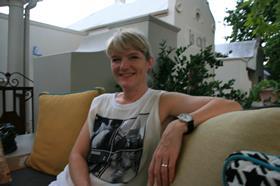
Margot Janse has twice been crowned South Africa’s Chef of the Year and is the creator of a unique five and eight-course innovative tasting menu, à la Heston Blumenthal, at The Tasting Room in Franschoek. Here she tells Nina Pullman how she persuades her son to eat more veg and comes up with what might well be the best answer ever-recorded to the female chef question.
What’s your background?
I wanted to be an actress when I was really young, and I went to drama school in Holland. But they felt I was too naive and I should see the world. And of course they were right, but I didn’t think so then when I was 19.
I followed my South African boyfriend to Zimbabwe in 1989 because he was a journalist and was in exile so he couldn’t go back to South Africa. We were there for three months, and in that time everything started changing – Madiba (Nelson Mandela) was released, the political prisoners were released. We went to cover that story in Zambia at the headquarters of the ANC. And I had a camera, so I took pictures, and that’s how I sort of rolled into photography. So I have these unbelievable photographs of Mandela and all these people who had just come out of jail.
When we moved to Johannesburg I got involved with a photography school. I loved it, but I was always cooking, and at 23 I realised that’s what I wanted to do. I got a job in a restaurant called Ciro at the Ritz that took on apprentices, and one of them took me under his wing and taught me all the techniques.
How did you learn to experiment with food?
Nobody ever taught me the rules, so I could play. I would stay between lunch and dinner and I would create. I don’t know where it came from. I would take zucchini blossoms and make prawn mousse – I don’t know where I picked that up. I must have read it in a recipe book. And then Ciro (the owner of Ciro's restaurant) would come back at six, and I’d say there you go, and he’d say that’s on the specials tonight. It was a very positive environment. It was like a playground.
What’s it like to be a female chef?
It must be the answer I get asked the most. And I’m like, you know what, I have no comparison because I’ve never been a male one. There are pockets of things I could tell you about. But at the same time, the more I talk about it the more I make it an issue. Do we discuss it until we’re blue in the face, or do I just cook? Do I have boobs? Yes. Does it make a difference? I don’t know. For me it’s tough because I have a child. That is tougher than if I was a father, and I think that has a lot to do with why women stop doing it.
Professional men and women are still not viewed equally. But the more I highlight it the more I add to that. I’m not saying don’t talk about it, but I’m not trying to make a problem out of it. We can talk about it – sure.
How has South Africa changed?
As South Africa became free and democratic, people started liking it again. South Africa really had a huge complex, everything was better if it came from overseas: people, wine, as long as it wasn’t South African it was better. Over the last 20 years this pride has come back. People started visiting and saying the people are so nice, the tomatoes are so tasty, so a sense of worth started to come back.
How does your work connect up with stone fruit industry?
My link is what is available I use. If it’s in season I use it. I love Nectar Gold, which I think is a nectarine crossed with a cling peach, they are fantastic. And we did a big five-course lunch made entirely of apples and pears for a Tru-Cape function last year.
You started a project to cook healthy school lunches for nearby schoolchildren. When did you first become aware of malnutrition in South Africa?
I think you are always aware of it. But I have a son, he’s nine, and I think that’s when you really start thinking about what do I feed my child. I think when I became a mother I realised how privileged my child is. He’s healthy and strong, and smart, and he goes to school with a good breakfast and a lovely lunch box.
How can you encourage children to eat healthily?
It’s about understanding that a carrot is a carrot, and pork comes from a pig, and beef comes from a cow. Don’t make it boring and negative like you must eat your vegetables. Make it exciting and then they’ll eat it. So for sugar snap peas I would say listen, look there are peas inside. And he still calls them noisy peas!



